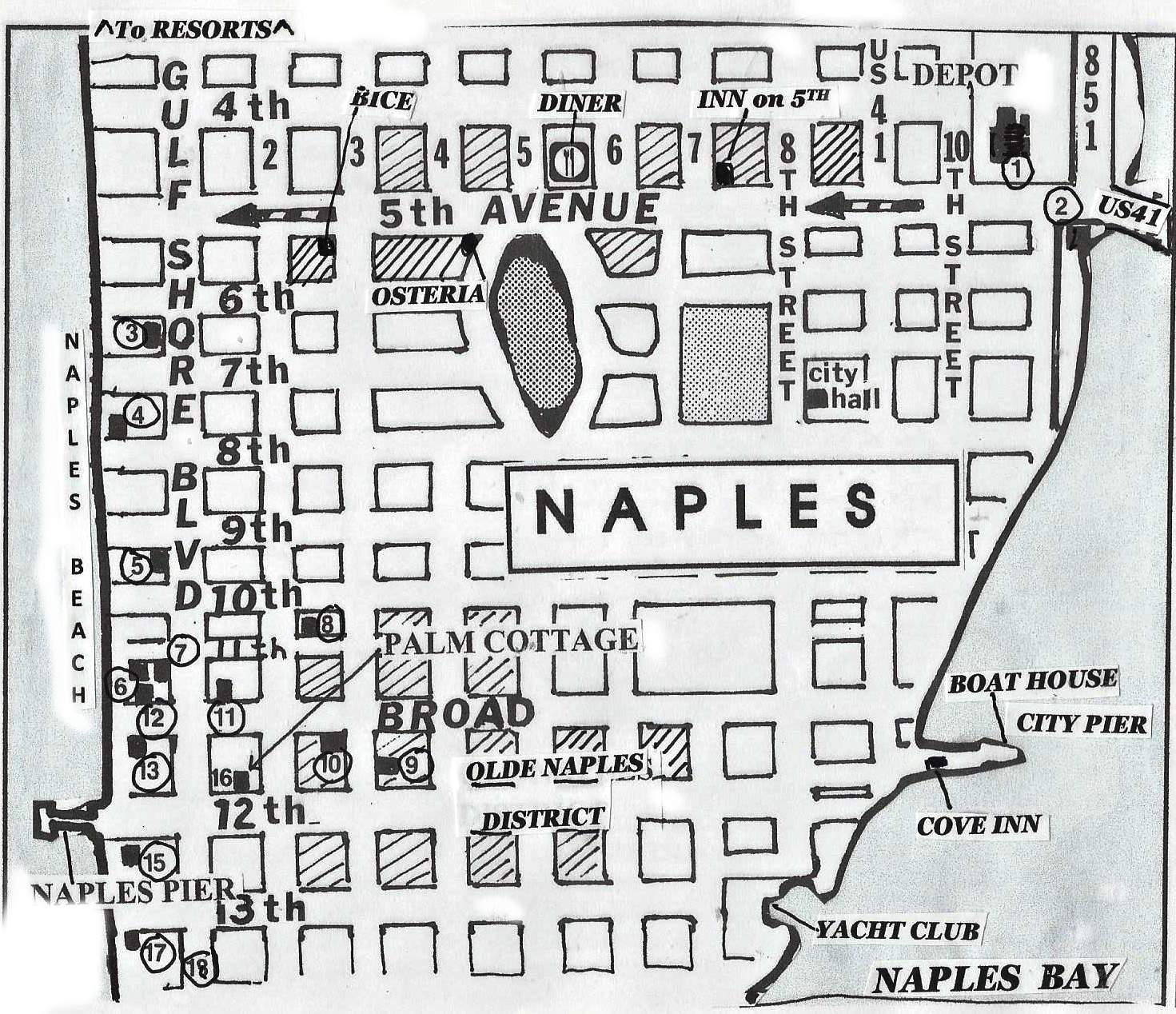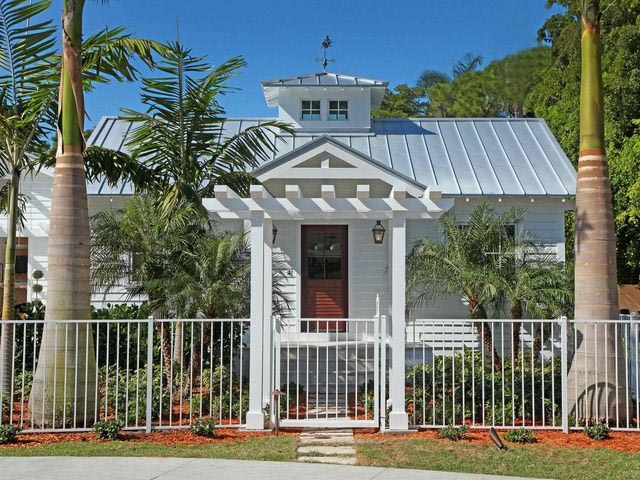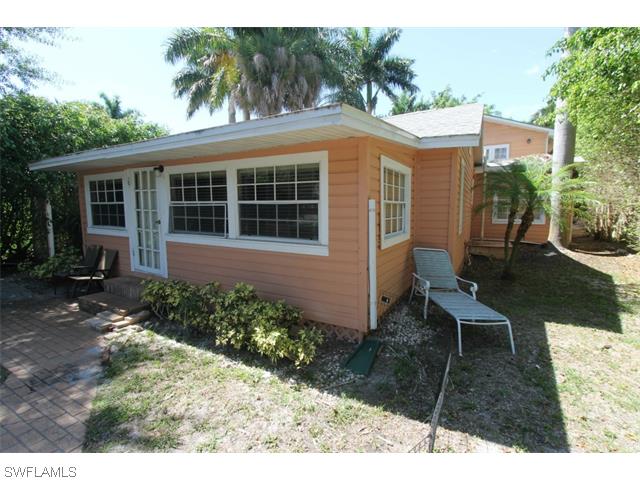
NAPLES
(Collier County)
THE GULF COAST'S
SOUTHERN RESORT
NAPLES remained a "Last Frontier" except for Cuban
fishermen and adventurers until 1885 when General John S. Williams and
Walter N. Haldeman, publisher of the Louisville
Courier-General led a group of families to a bay which reminded the General of
Naples Bay. They started a sixteen room hotel and built a 1,000 foot dock to
attract steamboats.
The region gained more permanent residents by
1914 when Edward Crayton began the Naples Improvement
Company to develop waterways and wide palm-lined avenues.
By the time of the arrival of the railroad, Naples was known as a
subtropical paradise. A huge growth boom took place in the 1950s and 1960s with Northern visitors, but recently a large influx of people have arrived from the Florida East Coast..

WHERE TO START: Start at the corner of US41 and Fifth Avenue, the glamour shopping heart of Naples, and travel a few
blocks west to the historic:
(1) NAPLES
DEPOT (1926), 1051 5th
Avenue South, the logical start of a tour since
the arrival of the Seaboard
Coast line assured the
winter resort's growth. The three sided open arcade of Spanish Colonial style,
designed by L. Philips Clarke, contains a museum of local history and the
popular Bardley Gallery. STOP to also tour the
railroad cars.
To the left across US41 on the west bank of
the Gordon River is:(2) TIN CITY MARINE MARKET PLACE, 1200 Fifth
Avenue, a forty shop rustic mall with tourist shops and appropriate seafood
places You can take a boat tour to Keewaydin Island
or Naples Bay with TIKI ISLANDER BOAT TOURS and other firms on the docks. Across US41 is the riverfront BAYFRONT INN, complete with a yacht basin on the river.
DRIVE back WEST ON FIFTH AVENUE across US41 into NAPLES' FIFTH AVENUE SHOPPING
DISTRICT, ten blocks of the most exclusive shops outside of Worth Avenue, Palm
Beach.
If it is the winter season a trolley will be
commuting along for shoppers. It is hard to imagine this was once a landing
strip for Charles Lindbergh. Fifth Avenue is a great place to park and shop and have lunch. The street is filled with restaurants from the fancy italian OSTERIA TULIA(466 Fifth Avenue) to the THAI UPON CAFE(409 Fifth Avenue)
Naples is a difficult place for history seekers for most of the fifty homes that exist older than 1955 are small cottages often converted into expensive places. Many of the largest estates are hidden behind walls and thick vegetation. The average house in Naples was built in 1987, hardly historical to most visitors. The oldest cottages were not influenced by the Mediterranean Revival architecture of the Florida Land Boom and reflect a diversity of bungalow styles.,
.
Continue toward the Gulf on Fifth Avenue to GULF SHORE BOULEVARD.
If you go north you'll reach newer resorts and LOWDERMILK PARK,
a 1,000 foor urban beach with full facilities. To
tour the older areas, turn SOUTH
ON GULF SHORE BOULEVARD.
Naples Beach has access for limited parking on some streets to
your right. Drive in and out as you like, but I'll point out some of the older
or ancient homes.
At (3)
670 GULF SHORE BOULEVARD (1935) is a
two story Spanish- Mediterranean house with a big garage and standard red tile
roof, designed by Addison Mizner, the builder of Boca Raton. Naples is one of the rare
West Coast spots with Mizner homes. The largest house is PINEAPPLE PLANTATION (1930), designed by George Upton but drastically altered in restoration.
Another Mizner gem
is at the foot of 8th Avenue,
the (4) TIMKEN HOUSE (The Tile House) (1925). a
two story Spanish-Mediterranean. It was designed by Phineas Paist whose Coral Gables works included the Ventian Pool and the Old Campus at the University of Miami As you REACH 9TH AVENUE, you are nearing some of the original Naples
development.
At 926 Gulf Shore
Boulevard is the hidden by trees (5) OLD HEWITT HOUSE
(1913), a one story frame heavily shuttered beach place. TENTH AVENUE was the site of the Old Indian Canal. At 1144 Gulf Shore Boulevard is the (6) MANDALAY
HOUSE (1908), reached only by alleyway, and a large beach place. Nearby
at 88 11th Avenue
is the (7) WHAYNE HOUSE (1933), one of the earliest luxury
residences built in neighborhood. 11th Avenue is in the center of the Naples Historic Distruct and most of these houses merit a view., such as the 1930 PERIWINKLE COTTAGE at 123 llth Avenue, and at 157 11th Avenue WESTHAVEN (1920), a massive bungalow built on four lots by Colonel Robert West.
If you GO EAST ON 11TH AVENUE across Gulf
Shore, you'll reach OLDE NAPLES, several blocks of interesting
shops and restaurants mostly along THIRD STREET SOUTH. A delightful board and
batten home is (8) MARTHA'S COTTAGE (1922) at 205 11th Avenue.
Naples
in 1928 – The Commercial District


Turning south on Third Street, you'll pass Naples' oldest commercial
district. Among the key buildings is the: (9) NAPLES MERCANTILE BUILDING
(1919), 1171 Third Street,
a two-story frame structure covered with stucco. On the opposite side of he
road is the (10) OLDE NAPLES BUILDING (1922), 1167 Third
Street, the headquarters of the Naples Improvement Company, the first town hall,
and the village's first movie house. Both structures have large historic signs. Some of you will want to shop here also.
TURN WEST ON BROAD AVENUE, which has many old structures. At 239 Broad is the 1919 FISHERMANS LODGE, a two story Dade County pine cottage moved to this location. At 107 Broad Avenue is the (11) DR.
EARL BAUM HOUSE (1947), home of the doctor and naturalist whose collections
since 1922 attracted countless wildlife lovers to region to study. At 88 Broad Avenue is the 1935 HONEYMOON COTTAGE, a two-story cedar shake building with a steep gable.The (12) McKEE HOUSE (1928), 53 Broad Avenue, is a two story frame
beach house with a stamped, metal roof.
Across the road at 38 Broad Avenue, is the (13) JOHN S.
JONES HOUSE (1922), an Ohio
railroad and coal executive who served as head of the Naples Improvement
Company.
CONTINUE SOUTH ON GULF
SHORE TO 12TH AVENUE where you see
the symbol of the community, the: (14) NAPLES PIER (1960), at the
foot of 12th Avenue. Started in 1888 as a passenger dock, once with a narrow
gauge railroad and then with a post office, the pier has been rebuilt after
hurricanes in 1910, 1926, and 1960, and in 1922 after a terrible fire.
Once located at 60
12th Avenuewas the (15) GENERAL JOHN S.
WILLIAMS HOUSE (1886), built by the first developer of Naples and sold to his
friend William Haldeman who did most of the
additions: seven bedrooms and four baths. The house was rescued and relocated to Oak Creek in Bonita Springs. It is a major victory for the preservation of the history of Collier County.
CONTINUE EAST ON 12TH AVENUE to see the historic: (16) PALM
COTTAGE (1890), 137 12th Avenue, the two story tabby home of Walter N. Haldeman who built the first hotel right where 12th Avenue
ends at Gordon. Louisville Editor Henry Watterson was an owner, but today the
house serves as a museum and center for the COLLIER COUNTY
HISTORICAL SOCIETY.







